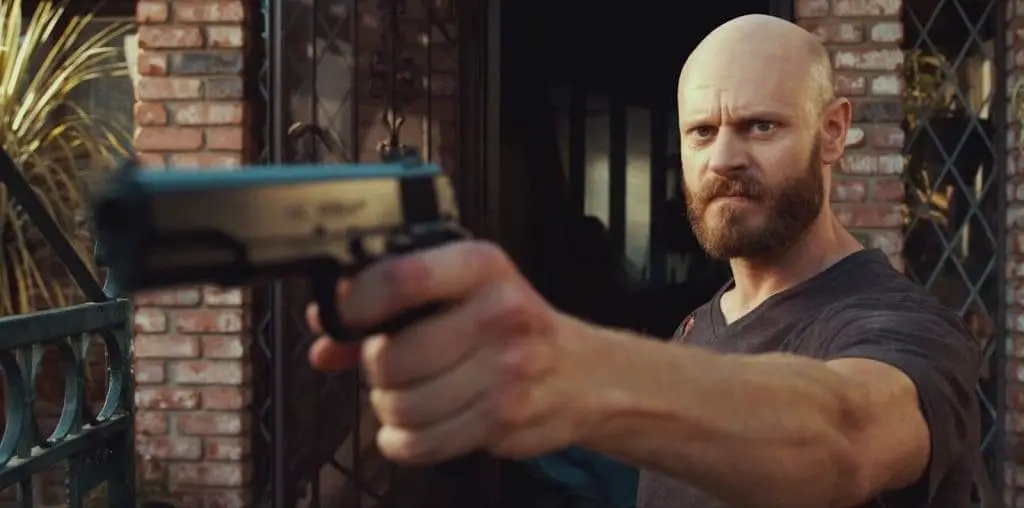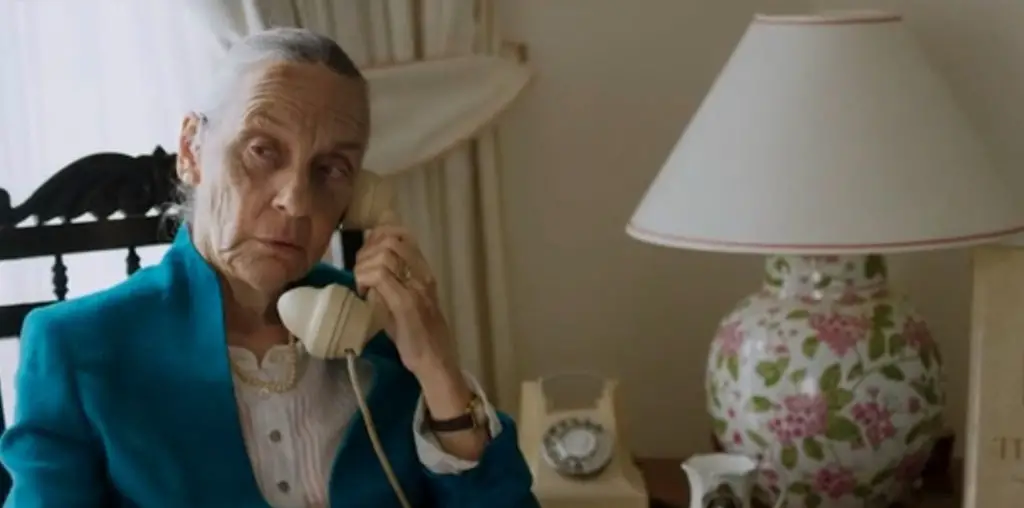
Why should you care about Jackie Chan? Good question. Jackie Chan is quite possibly the biggest movie star in the world. He has been the biggest box office draw throughout Asia for over twenty years. His greatest legacy, though, will be his monumental contributions to fight choreography and the development of action films. Chan’s self-effacing demeanor masks a total obsession with the extremes and perfection of physical movement.
When Bruce Lee died suddenly in 1973, the Hong Kong film industry fell into chaos. Producers searched desperately, in futility, to find a successor, to fill his shoes. Following a long, hard life in training and stuntwork, a young Jackie Chan tried them on. They didn’t fit him, so he tried on something more suitable to his personality. Instead of Lee Chan looked to another hero, Buster Keaton. Beginning with “Snake in Eagle’s Shadow”, Chan created a persona of a normal, flawed person, just trying to get by. He never gets laid. He’s not that bright. He will probably run from danger. However, if backed up against a wall, he will definitely kick your a*s. Audiences adored both Chan and this new, humanized approach.
In 1983, after a failed attempt to break into Hollywood, Chan returned home with new zeal and determination. He would create fight scenes that no one had ever seen before or even dreamed possible. With “Project A”, the real legend began. Doing the vast majority of his own stunts, and pressuring co-stars to do the same, Chan choreographed scene of elaborate movement that could only be compared with ballet (but involving stuff like violence and furniture). Difficult? Hell, most Hong Kong movies of the time are shot in a few weeks with actors working on more than one movie at a time. Chan would spend more than a month on a single fight scene, UNTIL HE GOT IT RIGHT. In the process, he’s broken enough bones to call Evel Knievel a p***y. Unfortunately, the non-fighting parts of the films didn’t quite get the same amount of attention.
Between a lack of new challenges and the then impending transfer of Hong Kong to China, Chan has seemed a bit unfocused for most of the ’90’s. Rampant transfer anxiety propelled many an actor and director to try their luck in Los Angeles, so Jackie took another shot at Hollywood. With “Rush Hour”, he scored. He has not abandoned his home town yet, as he now alternates film productions between America and Hong Kong.
Chan still finds himself facing old rival Jet Li in America, but there’s room enough for both of them. As the old stars, such as Arnold Schwarzenegger and Sylvester Stallone begin to fade, Chan and Li are ready to take their places as the new action stars for the 21st century. Then again, Jackie is now 46. How much longer can Chan take this kind of punishment?
[ I AM… THE JACKIE CHAN TIMELINE ]
[ April 7, 1954 ] ^ Born Chan Kong-San in Hong Kong. His family was so poor when he was born, his parents offered to sell him to the British doctor who delivered him.
[ 1961 ] ^ After the family had moved to Australia, six-year-old Jackie was sent back to Hong Kong to be indentured at Sifu Yu Jim Yuen’s China Drama Academy (Chinese opera school) for ten years.
From 5am to nearly midnight daily, the young boy trained in traditional Peking Opera. Under threat of caning and food deprivation, he learned singing, dancing, mime, acrobatics and a variety of martial arts.
The schoolmaster, Yu Shan Yuan, the strict master of the school, placed Chan in a student performance troupe called the Seven Little Fortunes with future talents Sammo Hung and Yuen Biao.
The close friends referred to themselves as the Three Brothers. The trio would appear together in “Wheels on Meals” (1983) and “Dragons Forever” (1988), both directed by Hung, and the Chan-directed “Project A” (1983).
[ 1962 ] ^ School loans out Chan for first film role at age eight in the Cantonese feature “Big and Little Wong Tin Bar”. Appeared in more than 25 films by age ten.
[ 1971 ] ^ Chan graduated opera school at age 17. Found work as a stunt man using the name Chen Yuen-Lau. First acting role as an adult, “Little Tiger from Canton”.
[ 1972 ] ^ Serving as the stunt double for the dreaded Mr. Suzuki in “Fist of Fury”/”The Chinese Connection”, Chan successfully executed the highest fall ever attempted in a HK film at the time, received props from impressed star, Bruce Lee.
[ 1975 ] ^ Earning little money as a stuntman, Chan moved to Australia to be with parents. Reputedly, given nickname Jack while working construction. Soon sick of Australia, moved back to Hong Kong.
[ 1976 ] ^ Worked again with Sammo Hung and Yuen Biao as star of “Strike of Death” for little known director John Woo.
[ 1978 ] ^ Chan has first hit in lead role in “Snake in Eagle’s Shadow”. Early use of comic persona, usually as a country bumpkin. Directed by Yuen Woo-Ping, director of several major Jet Li films and fight choreographer for “The Matrix”.
[ 1980 ] ^ Made American film debut, starred in “The Big Brawl”, also co-starred in “Cannonball Run”. Disillusioned, he returned to HK intent on concentrating on improving his films for the Asian market by making far more elaborate action-comedies.
[ 1983 ] ^ Secretly married actress Joanne Lin (Lin Feng-Jiao). Kept secret to not alarm fans. The couple barely see each other due to higher priority on Chan’s career.
[ 1984 ] ^ Son Jackson Chan born. Family still secret. Chan barely sees son, either.
[ 1985 ] ^ Japanese newspaper prints rumor of marriage. Two female fans attempt suicide, one successfully (jumps in front of bullet train).
So many stuntmen were injured on the Chan-directed “Police Story”, no insurance company would touch him and no stuntmen would work with him. He then formed the Jackie Chan Stuntmen Association, where he recruited and trained the stuntmen himself, and paid all medical bills out of his own pocket.
During making of “Armour of God”, Chan almost dies during a simple stunt when he jumped from a wall to a tree branch… and it broke. He fell 40 feet, pretty much head first. Now has plate in his head and partial deafness to remember it by.
[ 1989 ] ^ Chan turned down an offer from Michæl Douglas to co-star as a villain in Ridley Scott’s “Black Rain”.
[ 1999 ] ^ Long an icon of public virtue, Chan is forced to an admit extramarital affair after mistress got pregnant. Unrealistic Asian fans not pleased. Wife not too pleased, either.
[ I am… The Jackie Chan Timeline of Pain ]
[ 1975 ] ^ “Hand of Death” – Concussion.
[ 1978 ] ^ “Magnificent Bodyguard” – Broken hip.
“Dragon Fist” – Broken nose.
“Snake in Eagle’s Shadow” – Front tooth kicked out.
[ 1979 ] ^ “Drunken Master” – Concussion. Suffer broken eye socket after getting kicked in the face.
[ 1980 ] ^ “Young Master” – Broken nose.
[ 1982 ] ^ “Dragon Lord” – Broken jaw bone.
[ 1983 ] ^ “Project A” – Sprained neck after falling 10 meters from clock tower while imitating Buster Keaton. Re-broke nose in different stunt.
[ 1985 ] ^ “Armour of God” – During stunt, Chan fell out of a tree the wrong way, splitting his skull, inducing a brain hemorrhage. Skull fragments had to be removed from his brain. Now has plate in his head.
“Police Story” – While sliding down a Christmas-light covered pole, injures vertebræ 6-8, dislocates pelvic girdle, and scrapes skin off hands.
“The Protector” – Broke bones in hand.
[ 1987 ] ^ “Dragons Forever” – Impacted angle.
[ 1990 ] ^ “Operation Condor” – Sternum broken and dislocated. Puncture wound in leg.
[ 1991 ] ^ “Twin Dragons” – Glass shards in a*s.
[ 1992 ] ^ “Supercop” – Dislocated and fractured cheek bone. Broken shoulder. Fractures rib when hit by a helicopter.
“City Hunter” – Dislocates shoulder blade. Broken instep on foot.
[ 1993 ] ^ “Crime Story” – Both legs injured when caught between two cars.
[ 1994 ] ^ “Drunken Master II” – Burns hands and face during climactic fight scene. Injures back when kicked into a table.
“Rumble in the Bronx” – Jumps from bridge onto a hovercraft. Breaks ankle and toe so where bone pierced the skin.
[ 1995 ] ^ “Thunderbolt” – Cracks hipbone.
[ 1996 ] ^ “Mr. Nice Guy” – Dislocates neck and tears ligament in neck.
“First Strike” – Concussion. Nose injury.
[ STRANGE BUT PROBABLY TRUE ] ^ His Chinese stage name, Sing Lung, means “to become a dragon”.
He practices both southern and northern styles of Kung Fu, with some Hapkido, Karate, Judo, and other styles.
A huge singing sensation throughout Asia, Chan sang the title track for the Hong Kong release of Disney’s “Beauty and the Beast”.
Chan had his eyelids surgically altered in either the ’70’s or ’80’s to appear less ethnically Chinese.
Inspired by his participation in the “Cannonball Run” movies, Chan began playing outtakes and bloopers over the end credits of his films. This includes footage of how Jackie received all of his injuries.
Every once in a while, Chan does use a stunt double. This is primarily for tasks he doesn’t know how to do and can’t learn quickly, like skateboarding. He actually injured himself on a set once because he didn’t know how to roller-skate.
While touring the U.S. to promote his first American film, “The Big Brawl”, Chan was forcibly challenged to public fights on three occasions, twice with sucker attacks. Jackie ended each fight with a single move.
In 1995, director Wong Jing and Jet Li made a brutal parody film of Chan called “High Risk”. Jet portrays Kit, a former cop who joins the stunt team for action star Frankie Lane (Jacky Cheung as an emasculated Chan) who secretly performs all the stunts for which Frankie takes credit. The movie even mocks the size of Jackie’s penis.
In 1997, the African nation of Gambia issues of set of postage stamps with Chan’s image. The only other entertainers honored as such were Sylvester Stallone and Barbra Streisand. ‘Kay.
[ QUOTES ] ^ “Don’t try to be like Jackie. There is only one Jackie… Study computers instead.”
“…you can see in my movie there are a lot of accidents.”
[ 10 BEST HONG KONG FILMS ] ^ Snake in Eagle’s Shadow (1978) ^ Drunken Master (1979) ^ Project A (1983) ^ 5 Lucky Stars (1983) ^ Wheels on Meals (1984) ^ Police Story (1985) ^ Armour of God (1986) ^ Operation Condor (1990) ^ Supercop (1992) ^ Drunken Master II (1994)

